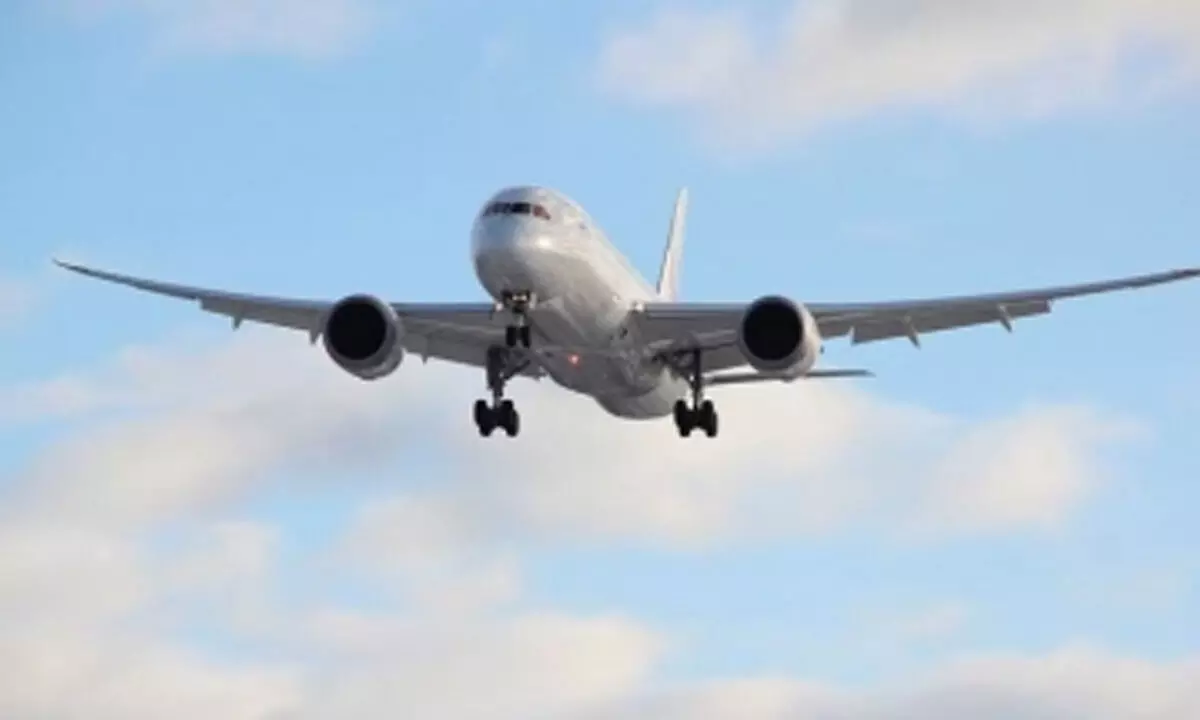Live
- Kothakota Seetha Dayakar Reddy takes charge as Telangana child rights panel chief, meets CM Revanth Reddy
- CM Revanth Reddy unveils logo of Veeranari Chakali Ailamma Women’s University
- CM Revanth Reddy directs formulation of comprehensive education policy in Telangana
- Top Lankan ministers, Indian diaspora accord grand welcome to PM Modi in Colombo amid heavy rain
- Zaggle partners with Thomas Cook India and SOTC Travel for a unified travel and expense management solution
- Did Sreeleela Just Reveal Her Look From Her Bollywood Debut?
- Avantel Secures ₹11.37 Crore Contract from Goa Shipyard Limited to Equip Indian Navy’s Next-Generation Offshore Patrol Vessel (NGOPV) with Advanced Satcom Solutions
- Rohit Sharma Misses MI vs LSG Clash Due to Knee Injury
- Nikon Sets New Standard with Stunning Autofocus Abilities, Powerful Low-Light Performance with Z5II
- NeuroGaint Systems Taps IBM to Deliver AI-Powered Letter of Credit Processing
Indian aviation sector to log 8-13 pc passenger traffic growth in FY24

Credit rating agency ICRA on Wednesday said the Indian air passengers traffic is expected to grow by 8 to 13 per cent in FY24 to touch 150-155 million to surpass the pre-Covid levels of 141.2 million in FY20.
Chennai: Credit rating agency ICRA on Wednesday said the Indian air passengers traffic is expected to grow by 8 to 13 per cent in FY24 to touch 150-155 million to surpass the pre-Covid levels of 141.2 million in FY20.
The rating agency maintains a stable outlook for the Indian aviation sector amid the continued recovery in domestic and international air passenger traffic, and relatively stable cost environment.
According to ICRA, the growth momentum is expected to continue in FY2025 as well, with a similar estimated year-on-year (YoY) growth, aided by rising demand for both leisure and business travel and improving airport infrastructure.
The international passenger traffic for Indian carriers surpassed the pre-Covid levels in FY2023, although it trailed the peak levels of 25.9 million witnessed in FY2019.
"It is expected to cross this level in the current fiscal, with an estimated 25 to 27 million passengers, representing a YoY growth of 7 to 12 per cent. The same is expected to further grow by 7 to 12 per cent to 27-29 million in FY2025," ICRA said.
Commenting further, Suprio Banerjee, Vice-President and Sector Head -- Corporate Ratings, said: "The industry has witnessed improved pricing power, as reflected in increase in yields and thus the spread between revenue per available seat kilometre -- cost per available seat kilometre (RASK-CASK) for the airlines. The same is expected to remain favourable, aided by a decline in aviation turbine fuel (ATF) prices and the relatively stable foreign exchange rates. The industry is thus estimated to report a significantly lower net loss of about Rs 30-40 billion in FY2024 and FY2025 compared to about Rs 170-175 billion in FY2023."
ATF prices and Rs-$ movement have a major bearing on the airlines' cost structure.
The average ATF price stood at Rs 103,547/KL in 11M FY2024, a YoY decline of 15 per cent compared to Rs 120,978/KL in FY2023.
However, this was 60 per cent higher compared to an average of Rs 64,715/KL during FY2020. Fuel accounts for about 30-40 per cent of the airlines' expenses, while about 35-50 per cent of the airlines' operating expenses -- including aircraft lease payments, fuel expenses, and a significant portion of aircraft and engine maintenance expenses -- are denominated in $ terms.
Furthermore, some airlines have foreign currency debt. While domestic airlines also have a partial natural hedge to the extent of earnings from their international operations, overall, they have net payables in foreign currency.
At present, the Indian aviation industry has a total order book of about 1,700 aircraft, which is more than double the size of the current fleet.
The deliveries, however, are likely to be gradual, spanning over the next decade, and will also be impacted by the current supply chain challenges encountered by engine and aircraft original equipment manufacturers (OEMs).
Also, a large part of these is towards replacement of old aircraft with new fuel-efficient ones, and ICRA expects the demand-supply balance to be maintained in the medium to long term, aided by improvement in air penetration levels. Furthermore, a sizeable part of the aircraft addition by airlines will also be meant for expanding international operations.
"More recently, the Indian aviation industry has been affected by engine failures and supply chain challenges. This has resulted in grounding of aircraft for select airlines, thus impacting overall industry capacity (as measured by available seat kilometer or ASKMs), with nearly 20-22 per cent of the total industry fleet grounded as on September 30, 2023. The recent powder-coating-related concerns in engines are expected to result in additional grounding of aircraft in Q4 FY2024, implying that about 24-26 per cent of the industry capacity will be grounded by March 31, 2024, thus affecting the industry's ASKMs," Banerjee said.
"This will also result in higher operating expenses for the airlines with extra cost of grounding, an increase in lease rentals due to additional aircraft being taken on lease to offset the grounded capacity, along with increasing lease rates and lower fuel efficiency (as these grounded aircraft get temporarily replaced by older aircraft), thus adversely impacting the airlines' cost structure. However, healthy yields, high passenger load factor, and partial compensation available from engine OEMs would help absorb the impact to an extent," Banerjee added.

© 2025 Hyderabad Media House Limited/The Hans India. All rights reserved. Powered by hocalwire.com






